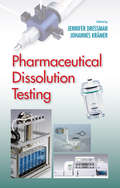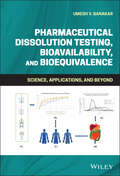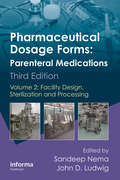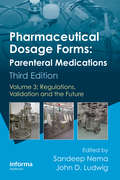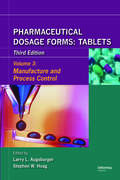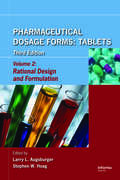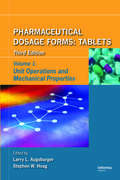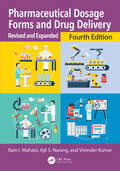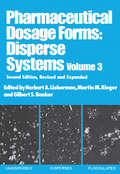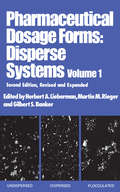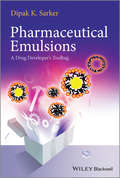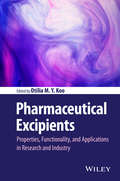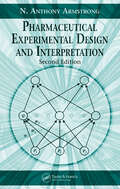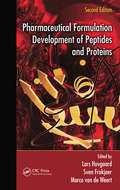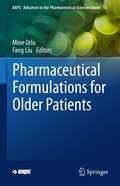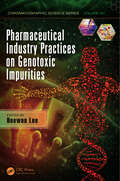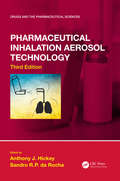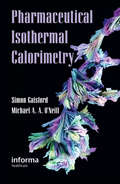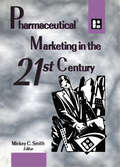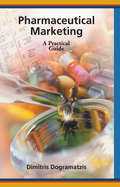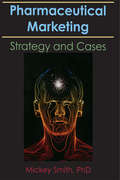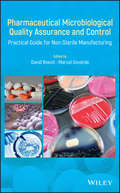- Table View
- List View
Pharmaceutical Dissolution Testing
by Johannes Krämer Jennifer DressmanAn expertly written source on the devices, systems, and technologies used in the dissolution testing of oral pharmaceutical dosage forms, this reference provides reader-friendly chapters on currently utilized equipment, equipment qualification, consideration of the gastrointestinal physiology in test design, the analysis and interpretation of data
Pharmaceutical Dissolution Testing, Bioavailability, and Bioequivalence: Science, Applications, and Beyond
by Umesh V. BanakarExplore the cutting-edge of dissolution testing in an authoritative, one-stop resource In Pharmaceutical Dissolution Testing, Bioavailability, and Bioequivalence: Science, Applications, and Beyond, distinguished pharmaceutical advisor and consultant Dr. Umesh Banakar delivers a comprehensive and up-to-date reference covering the established and emerging roles of dissolution testing in pharmaceutical drug development. After discussing the fundamentals of the subject, the included resources go on to explore common testing practices and methods, along with their associated challenges and issues, in the drug development life cycle. Over 19 chapters and 1100 references allow practicing scientists to fully understand the role of dissolution, apart from mere quality control. Readers will discover a wide range of topics, including automation, generic and biosimilar drug development, patents, and clinical safety. This volume offers a one-stop resource for information otherwise scattered amongst several different regulatory regimes. It also includes: A thorough introduction to the fundamentals and essential applications of pharmaceutical dissolution testing Comprehensive explorations of the foundations and drug development applications of bioavailability and bioequivalence Practical discussions about solubility, dissolution, permeability, and classification systems in drug development In-depth examinations of the mechanics of dissolution, including mathematical models and simulations An elaborate assessment of biophysiologically relevant dissolution testing and IVIVCs, and their unique applications A complete understanding of the methods, requirements, and global regulatory expectations pertaining to dissolution testing of generic drug products Ideal for drug product development and formulation scientists, quality control and assurance professionals, and regulators, Pharmaceutical Dissolution Testing, Bioavailability, and Bioequivalence is also the perfect resource for intellectual property assessors.
Pharmaceutical Dosage Forms - Parenteral Medications: Volume 2: Facility Design, Sterilization and Processing
by Sandeep Nema John D. LudwigThis three-volume set of Pharmaceutical Dosage Forms: Parenteral Medications is an authoritative, comprehensive reference work on the formulation and manufacture of parenteral dosage forms, effectively balancing theoretical considerations with the practical aspects of their development. As such, it is recommended for scientists and engineers in the
Pharmaceutical Dosage Forms - Parenteral Medications: Volume 3: Regulations, Validation and the Future
by Sandeep Nema John D. LudwigThis three-volume set of Pharmaceutical Dosage Forms: Parenteral Medications is an authoritative, comprehensive reference work on the formulation and manufacture of parenteral dosage forms, effectively balancing theoretical considerations with the practical aspects of their development. As such, it is recommended for scientists and engineers in the
Pharmaceutical Dosage Forms - Tablets: Manufacture and Process Control
by Larry L. Augsburger Stephen W. HoagThe ultimate goal of drug product development is to design a system that maximizes the therapeutic potential of the drug substance and facilitates its access to patients. Pharmaceutical Dosage Forms: Tablets, Third Edition is a comprehensive treatment of the design, formulation, manufacture, and evaluation of the tablet dosage form. With over 700 i
Pharmaceutical Dosage Forms - Tablets: Rational Design and Formulation
by Larry L. Augsburger Stephen W. HoagPharmaceutical Dosage Forms: Tablets, Third Editionis acomprehensive treatment of the design, formulation, manufacture, and evaluation of the tablet dosage form. The ultimate goal of drug product development is to design a system that maximizes the therapeutic potential of the drug substance and facilitates its access to patients;
Pharmaceutical Dosage Forms - Tablets: Unit Operations and Mechanical Properties
by Larry L. Augsburger Stephen W. HoagPharmaceutical Dosage Forms: Tablets, Volume 1examines the fundamental physical and chemical processes that the different unit oprations use, and then applies this knowledge to the discussion of the varying unit operations and processes.This volume covers:
Pharmaceutical Dosage Forms and Drug Delivery: Revised and Expanded
by Ram I. Mahato Ajit S. Narang Virender KumarCompletely revised and updated, this fourth edition elucidates the principles of pharmaceutics, biopharmaceutics, dosage form design, and drug delivery – including emerging new biotechnology-based treatment modalities. The authors integrate aspects of physical pharmacy, chemistry, biology, and biopharmaceutics into drug delivery.With the expiration of older patents and generic competition, the biopharmaceutical industry is evolving faster than ever. Consequently, this edition of the book emphasizes the heightened focus that the recent remarkable progress in gene editing, immunotherapy, and nanotechnology has brought to the design of new drugs and diagnostic approaches along with novel dosage forms.Apart from new chapters, this edition highlights the emerging emphasis on the role of artificial intelligence (AI) in drug discovery, mRNA and antibody-based therapies, genome editing, immunotherapy, chemical kinetics, and the stability of drug products.Features: · Includes new chapters on antibody therapeutics, gene editing, and immunotherapy.· Explains newer approaches and future methods and the significance of artificial intelligence (AI) in drug discovery. · Updated sections on pharmacy mathematics, chemical kinetics, and the stability of medicinal products. · Important updates on parenteral drug products, protein and peptide treatments, and biotechnology-based pharmaceuticals to provide a contemporary perspective on drug development, delivery, and pharmaceutical sciences.· Expansion of review questions and answers to clarify concepts for students and add to their grasp of key concepts covered in this book.Although there are numerous books on pharmaceutics and dosage forms, most cover different areas of the discipline and do not provide an integrated approach. The integrated approach of this book not only provides a singular perspective of the overall field, but also supplies a unified source of information for students, instructors, and professionals, saving their time and money.•
Pharmaceutical Dosage Forms: Disperse Systems
by Martin M. Rieger Herbert A. Lieberman Gilbert S. BankerThis third volume of the second edition offers information on specialized products such as emulsions, liposomes, polymers and polymeric pharmaceutical excipients. It explains the requirements for conducting clinical research and obtaining marketing approval for new drug products
Pharmaceutical Dosage Forms: Disperse Systems (Pharmaceutical Dosage Forms: Disperse Systems Ser.)
by Martin M. Rieger Herbert A. Lieberman Gilbert S. BankerStressing the theory involved in formulating suspensions, emulsions, and colloidal drug products, this Second Edition of a well-received reference test highlights typical formulations, the avoidance of formulation pitfalls, and compliance with established regulatory principles.
Pharmaceutical Dosage Forms: Parenteral Medications
by Kenneth E. Avis Herbert A. Lieberman Leon LachmanCompletely updated and enlarged to three volumes (originally published as two volumes), the Second Edition of Pharmaceutical Dosage Forms: Parenteral Medications examines every important aspect of sterile drug products. This volume (3) offers comprehensive coverage of medical devices, quality assurance and regulatory issues.;This in-depth reference and text: discusses regulatory requirements in record-keeping based on the US Food and Drug Administration's (FDA) Current Good Manufacturing Practices; places special emphasis on methods of detecting, counting and sizing particles; offers new perspectives on contemporary validation concepts and how they affect the validation process; explains current FDA enforcement activities, the voluntary compliance policy, select court cases, and how these relate to parenterals; provides recent materials on the use of audits as a means of verifying the efficacy of manufacturing control systems; highlights new US regulations for medical devices; and examines quality assurance, including new information on biological control tests for medical device materials.;With the contributions of leading experts, volume 3 of Pharmaceutical Dosage Forms: Parenteral Medications is intended as a day-to-day reference for pharmacists, medical device manufacturers, quality control and regulatory personnel, chemists and drug patent and litigation attorneys, as well as a text for upper-level undergraduate, graduate and continuing-education students in the pharmaceutical sciences.
Pharmaceutical Emulsions
by Dipak Kumar SarkerPharmaceutical Emulsions: A Drug Developer's Toolbag covers all the key aspects of pharmaceutical emulsions, starting from the fundamental scientific basics, to the pharmaceutical forms and the chemical tests for its application. The author uses his extensive experience in both industry and academic experience to provide a concise, student friendly guide to the essential fundamentals of physical pharmacy.Divided into three clear sections, the text begins with Section A - Consideration for Product: Medicinal Formulation which includes a historical perspective, explanation of what is an emulsion, stability and instability, and manufacture. Section B - Forms, Use and Application follows, with chapters on creams and ointments, pastes and bases, colloids, transdermal, gels and implants. The final Section, Tests: Chemistry to control the quality, efficacy and fitness for purpose of the product includes chapters on physic-chemical properties, sizing and microscopy, rheology, QC and finally questions, calculations and dilemmas. Throughout the text there are numerous figures, diagrams and tables to engage the reader.This is an invaluable reference for all students of pharmaceutical sciences, pharmacy industrial pharmaceutical sciences, physical pharmacy and pharmaceutical forms as well as industry professionals
Pharmaceutical Excipients: Properties, Functionality, and Applications in Research and Industry
by Otilia M. KooThis book provides an overview of excipients, their functionalities in pharmaceutical dosage forms, regulation, and selection for pharmaceutical products formulation. It includes development, characterization methodology, applications, and up-to-date advances through the perspectives of excipients developers, users, and regulatory experts.* Covers the sources, characterization, and harmonization of excipients: essential information for optimal excipients selection in pharmaceutical development* Describes the physico-chemical properties and biological effects of excipients* Discusses chemical classes, safety and toxicity, and formulation* Addresses recent efforts in the standardization and harmonization of excipients
Pharmaceutical Experimental Design (Drugs and the Pharmaceutical Sciences)
by Gareth A. Lewis Didier Mathieu Roger Phan-Tan-LuuThis useful reference describes the statistical planning and design of pharmaceutical experiments, covering all stages in the development process-including preformulation, formulation, process study and optimization, scale-up, and robust process and formulation development.Shows how to overcome pharmaceutical, technological, and economic constraint
Pharmaceutical Experimental Design and Interpretation
by N. Anthony ArmstrongCompletely revised and updated, Pharmaceutical Experimental Design and Interpretation, Second Edition explains the major methods of experimental design and evaluation such as multivariate, sequential, and principal components analysis. With new sections on neural networks, artificial intelligence, fractional designs, and optimization techniques, th
Pharmaceutical Extrusion Technology (Drugs and the Pharmaceutical Sciences)
by Isaac Ghebre-Sellassie, Charles Martin, Feng Zhang and James DiNunzioThe first edition of Pharmaceutical Extrusion Technology, published in 2003, was deemed the seminal book on pharmaceutical extrusion. Now it is expanded and improved, just like the usage of extrusion has expanded, improved and evolved into an accepted manufacturing technology to continuously mix active pharmaceutical ingredients with excipients for a myriad of traditional and novel dosage forms. Pharmaceutical Extrusion Technology, Second Edition reflects how this has spawned numerous research activities, in addition to hardware and process advancements. It offers new authors, expanded chapters and contains all the extrusion related technical information necessary for the development, manufacturing, and marketing of pharmaceutical dosage forms. Key Features: Reviews how extrusion has become an accepted technology to continuously mix active pharmaceutical ingredients with excipients Focuses on equipment and process technology Explains various extrusion system configurations as a manufacturing methodology for a variety of dosage forms Presents new opportunities available only via extrusion and future trends Includes contributions of experts from the process and equipment fields
Pharmaceutical Formulation Development of Peptides and Proteins
by Lars Hovgaard Sven Frokjaer Marco van de WeertThe rapid advances in recombinant DNA technology and the increasing availability of peptides and proteins with therapeutic potential are a challenge for pharmaceutical scientists who have to formulate these compounds as drug products. Pharmaceutical Formulation Development of Peptides and Proteins, Second Edition discusses the development of therap
Pharmaceutical Formulations for Older Patients (AAPS Advances in the Pharmaceutical Sciences Series #51)
by Fang Liu Mine OrluPharmaceutical formulation design affects patient acceptability/adherence and pharmacokinetics of the drug. This is particularly important for older patients because of the physiological changes due to ageing and clinical/social circumstances related to medicine taking.This book provides a comprehensive review in the design of formulations to meet the needs of older patients. An overview of the key clinical, social and pharmaceutical factors affecting medication optimization, safety and acceptability in older adults is included, followed by patient-centric considerations including regulatory requirements, dosage form design and human factor studies.Advanced pharmaceutical technologies are discussed for their potential use in older adults such as 3D printing, long-acting oral formulations and novel vaccine technologies. The unique focus of the book will be of interest to pharmaceutical scientists in both industry and academia in searching for better formulations for older patients.
Pharmaceutical Industry Practices on Genotoxic Impurities (Chromatographic Science Series)
by Heewon LeeA great deal of confusion and uncertainty over genotoxic impurity (GTI) identification, assessment, and control exists in the pharmaceutical industry today. Pharmaceutical Industry Practices on Genotoxic Impurities strives to facilitate scientific and systematic consensus on GTI management by presenting rationales, strategies, methods, interpretati
Pharmaceutical Inhalation Aerosol Technology, Third Edition (Drugs and the Pharmaceutical Sciences #134)
by Anthony J. Hickey Sandro R. da RochaThis fully revised and updated third edition of Pharmaceutical Inhalation Aerosol Technology encompasses the scientific and technical foundation for the rationale, design, componentry, assembly and quality performance metrics of therapeutic inhalers in their delivery of pharmaceutical aerosols to treat symptoms or the underlying causes of disease. It focuses on the importance of pharmaceutical engineering as a foundational element of all inhaler products and their application to pulmonary drug delivery. The expanded scope considers previously unaddressed aspects of pharmaceutical inhalation aerosol technology and the patient interface by including aerosol delivery, lung deposition and clearance that are used as measures of effective dose delivery.
Pharmaceutical Isothermal Calorimetry
by Simon Gaisford Michael A. O'NeillPharmaceutical Isothermal Calorimetry discusses the application of isothermal calorimetric techniques to challenges encountered during the rational design and development of novel drugs and drug delivery systems. Providing a comprehensive review of recent research and trends, this book contains an expert discussion of research and applications to p
Pharmaceutical Marketing in the 21st Century
by Mickey SmithA group of experts, leaders in their fields, provide a formal conjecture on the nature of various aspects of pharmaceutical marketing in the early part of the twenty-first century. Pharmaceutical Marketing in the 21st Century is ideal for product managers, planners, and strategists as it provides guidance for the future of marketing pharmaceutical products. Internationally relevant, this book is now available in Japanese!
Pharmaceutical Marketing: A Practical Guide
by Dimitris DogramatzisDesigned as a practical guide for the pharmaceutical industry, this book covers how to apply cutting-edge marketing concepts and tools to the real-world intricacies of marketing a heavily regulated product whose success is determined not by the actual end-user, but by various industry stakeholders. From creating a worldwide vision that cascades into local tactics to managing a drug portfolio or pricing a particular product, this book guides readers through developing, implementing, and auditing a successful marketing strategy geared specifically to the pharmaceutical industry. It provides graphs, tables, worksheets, pharmaceutical case studies, and a sample marketing strategy.
Pharmaceutical Marketing: Strategy and Cases
by Mickey C. SmithReflecting the fascinating and dramatic changes in pharmacy, pharmaceutical education, and the pharmaceutical industry in recent years, this authoritative volume focuses on the practice of marketing both prescription and nonprescription medications. In a dozen comprehensive chapters, author Mickey Smith highlights the economic social, and
Pharmaceutical Microbiological Quality Assurance and Control: Practical Guide for Non-Sterile Manufacturing
by David Roesti Marcel GoverdeRelying on practical examples from the authors’ experience, this book provides a thorough and modern approach to controlling and monitoring microbial contaminations during the manufacturing of non-sterile pharmaceuticals. Offers a comprehensive guidance for non-sterile pharmaceuticals microbiological QA/QC Presents the latest developments in both regulatory expectations and technical advancements Provides guidance on statistical tools for risk assessment and trending of microbiological data Describes strategy and practical examples from the authors’ experience in globalized pharmaceutical companies and expert networks Offers a comprehensive guidance for non-sterile pharmaceuticals microbiological QA/QC Presents the latest developments in both regulatory expectations and technical advancements Provides guidance on statistical tools for risk assessment and trending of microbiological data Describes strategy and practical examples from the authors’ experience in globalized pharmaceutical companies and expert networks
